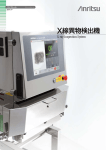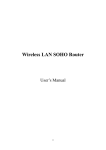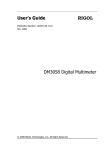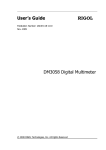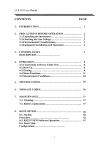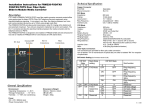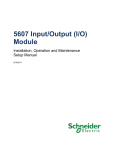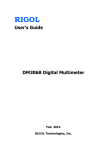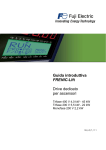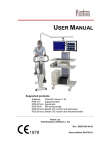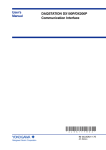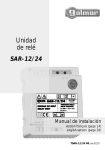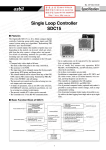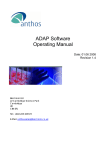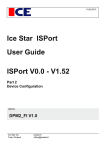Download Warranty - Schulz Electronic GmbH
Transcript
Warranty All Chroma instruments are warranted against defects in material and workmanship for a period of one year after date of shipment. Chroma agrees to repair or replace any assembly or component found to be defective, under normal use during this period. Chroma's obligation under this warranty is limited solely to repairing any such instrument which in Chroma's sole opinion proves to be defective within the scope of the warranty when returned to the factory or to an authorized service center. Transportation to the factory or service center is to be prepaid by the purchaser. Shipment should not be made without prior authorization by Chroma. This warranty does not apply to any products repaired or altered by persons not authorized by Chroma, or not in accordance with instructions furnished by Chroma. If the instrument is defective as a result of misuse, improper repair, or abnormal conditions or operations, repairs will be billed at cost. Chroma assumes no responsibility for its product being used in a hazardous or dangerous manner either alone or in conjunction with other equipment. be dangerous if misused. High voltage used in some instruments may Special disclaimers apply to these instruments. Chroma assumes no liability for secondary charges or consequential damages and in any event, Chroma's liability for breach of warranty under any contract or otherwise, shall not exceed the purchase price of the specific instrument shipped and against which a claim is made. Any recommendations made by Chroma for use of its products are based upon tests believed to be reliable, but Chroma makes no warranty of the results to be obtained. This warranty is in lieu of all other warranties, expressed or implied, and no representative or person is authorized to represent or assume for Chroma any liability in connection with the sale of our products other than set forth herein. CHROMA ATE INC. 43 Wu-Chuan Road, Wu-Ku Industrial Park, Taipei, Taiwan Tel: 886 -2-2298-3855 Fax: 886-2-2298-3596 www:http://www.chromaate.com E-mail:[email protected] SAFETY SUMMARY The following general safety precautions must be observed during all phases of operation , service , and repair of this instrument. Failure to comply with these precautions or specific WARNINGS given elsewhere in this manual will violate safety standards of design , manufacture , and intended use of the instrument. Chroma assumes no liability for the customer‘s failure to comply with these requirements. BEFORE APPLYING POWER Verify that the product is set to match with the line voltage. PROTECTIVE GROUNDING Make sure to connect the protective grounding to prevent an electric shock before turning on the power. NECESSITY OF PROTECTIVE GROUNDING Never cut off the internal or external protective grounding wire, or disconnect the wiring of protective grounding terminal. Doing so will cause a potential shock hazard that may bring injury to a person. FUSES Only fuses with the required rated current , voltage , and specified type normal blow , time delay , etc. can be used. Do not use different fuses or short-circuited fuseholders. To do so might cause a shock or fire hazard. DO NOT OPERATE IN AN EXPLOSIVE ATMOSPHERE Do not operate the instrument in the presence of flammable gases or fumes. DO NOT REMOVE THE COVER OF THE INSTRUMENT Operating personnel must not remove the cover of the instrument. Component replacement and internal adjustment can be done only by qualified service personnel. WARNING LETHAL VOLTAGES. Ac sources can supply 707 V peak at their output. DEATH on contact may result if the output terminals or circuits connected to the output are touched when power is applied. SAFETY SYMBOLS DANGER - High voltage . Explanation To avoid injury, death of personnel, or damage to the instrument, the operator must refer to an explanation in the instruction manual . Protective grounding terminal To protect against electrical shock in case of a fault. This symbol indicates that the terminal must be connected to ground before operation of equipment. WARNING A WARNING sign denotes a hazard. It calls attention to a procedure, practice, condition or the like which may result in injury or death of personnel if it is not rightly observed. Table of Contents 1. GENERAL INFORMATION............................................................................. 1-1 1.1 Introduction ....................................................................................................................................... 1-1 1.2 Description ......................................................................................................................................... 1-1 1.3 Key Features ...................................................................................................................................... 1-1 1.4 Specifications...................................................................................................................................... 1-2 1.5 Names of Parts ................................................................................................................................... 1-5 1.5.1 The Front Panel............................................................................................................................ 1-5 1.5.2 The Rear Panel............................................................................................................................. 1-7 2. INSTALLATION .............................................................................................. 2-1 2.1 Inspection ........................................................................................................................................... 2-1 2.2 Preparation for the Use..................................................................................................................... 2-1 2.3 Requirements of Input Power .......................................................................................................... 2-1 2.3.1 Ratings ......................................................................................................................................... 2-1 2.3.2 Input Connection ......................................................................................................................... 2-2 2.4 Output Connection ............................................................................................................................ 2-3 2.5 Remote Sense Connection ................................................................................................................. 2-6 2.6 The Procedures of Power-on ............................................................................................................ 2-7 3. LOCAL OPERATION...................................................................................... 3-1 3.1 Introduction ....................................................................................................................................... 3-1 3.2 Operation through Keypad .............................................................................................................. 3-1 3.2.1 Introduction.................................................................................................................................. 3-1 3.2.2 Data Entry.................................................................................................................................... 3-2 3.2.3 Output Setting.............................................................................................................................. 3-3 3.2.3.1 Setting Output Voltage and Frequency ................................................................................ 3-4 3.2.3.2 The Setting of Output Relay ................................................................................................ 3-6 3.2.3.3 The Output Status .................................................................................................................3-6 3.2.3.4 The Programming of 3-Phase Unbalanced Voltage .............................................................3-6 3.2.4 The Setting of Configuration........................................................................................................3-7 3.2.4.1 Remote Sense .......................................................................................................................3-7 3.2.4.2 External Reference ...............................................................................................................3-8 3.2.4.3 GPIB Address .......................................................................................................................3-9 3.2.4.4 The Setup of RS-232C..........................................................................................................3-9 3.2.4.5 The Saving..........................................................................................................................3-10 3.2.4.6 The Recalling......................................................................................................................3-10 3.2.4.7 More ...................................................................................................................................3-11 3.2.5 The Setting of Setup ...................................................................................................................3-11 3.2.5.1 The Output Range...............................................................................................................3-12 3.2.5.2 The Data Lock ....................................................................................................................3-12 3.2.5.3 The Setup of Buzzer ...........................................................................................................3-13 3.2.5.4 Protection............................................................................................................................3-13 3.2.5.5 The Saving/Recalling..........................................................................................................3-14 3.2.5.6 The SYSsetting ...................................................................................................................3-15 3.3 Applications ......................................................................................................................................3-15 3.3.1 The Execution of Output ............................................................................................................3-15 3.4 Measurement ....................................................................................................................................3-16 3.4.1 The Selection of Measurement Items .........................................................................................3-16 3.4.2 Measurement Functions..............................................................................................................3-18 3.5 Protection ..........................................................................................................................................3-19 Chroma 6460/6463/6490 User’s Manual 1. General Information 1.1 Introduction This manual describes five major things of the Chroma 6460/6463/6490 programmable ac source. They are specifications, installation, instructions on operation and theory of operation. In the manual the term, AC source, is applied to the Chroma 6460/6463/6490 programmable ac source. 1.2 Description The series of AC source is a high efficiency programmable ac power source, which is capable of simulating a wide variety of AC line conditions and accurate measurement of power. The microprocessor-controlled waveform oscillator generates accurate, stable output voltage and frequency. The PWM design of power stage allows for full volt-ampere into loads. The front panel has both RPG (rotary pulse generator) and keypad controls for setting the output voltage and frequency. The LCD provides a complete operating state of the unit to the user. Remote programming is accomplished either through the GPIB bus or the RS-232C serial port. 1.3 Key Features A. Configuration z z z z z Local operation from the keypad on the front panel. Remote operation via GPIB or RS-232C interface. Protection against Over-power, Over-load, Over-temperature, and Fan-fail. Temperature-controlled fan speed. Built-in output isolation relays. B. Input/Output z z z z Selective output voltage with full scale of 150V/300V for 6463/6490, and 150V/300V/500V for 6460. Remote control by the use of analog voltage reference. Full-page display of setup and measurement results. Measurement of V, I, F, P, CF, and PF. 1-1 Chroma 6460/6463/6490 User’s Manual 1.4 Specifications The operation specifications of the model 6460/6463/6490 are listed below (on the next page). All specifications have been tested according to the standard Chroma test procedures. All specifications are based on a remote sense connection, 25 ± 1°C, and resistor load unless specified otherwise. 1-2 Chroma 6460/6463/6490 User’s Manual Model 6460 6463 6490 OUTPUT PHASE 1 ( parallel or series ) 1 or 3 selectable 1 or 3 selectable OUTPUT RATINGS Power / Phase 6000VA 2000VA 3000VA Range/Phase 150V/300V(parallel) 300V/500V(series) 150V/300V 150V/300V Accuracy 0.2% of F.S. 0.2% of F.S. 0.2% of F.S. Resolution 0.1V 0.1V 0.1V Distortion 1% 1% 1% Line Regulation 0.1% 0.1% 0.1% Load Regulation 0.2%( series ) 0.8 %(parallel) 0.2%(3 phases) 0.8%( 1 phase) 0.2%(3 phases) 0.8%( 1 phase) Voltage Temp. coefficient 0.02%per 0.02%per 0.02%per Max. current/phase rms 60A/30A/15A (150V/300V/500V) 20A/10A (150V/300V) 30A/15A (150V/300V) peak 180A/90A/45A(45-100Hz) 60A/30A (45-100Hz) 90A/45A(45-100Hz) 150A/75A/38A(>100-1KHz) 50A/25A(>100-1KHz) 75A/38A(>100-1KHz) Range 45-1KHz 45-1KHz 45-1KHz Accuracy 0.15% 0.15% 0.15% Resolution 0.01Hz (45-99.9Hz) 0.01Hz (45-99.9Hz) 0.01Hz (45-99.9Hz) 0.1Hz (100-999.9Hz) 0.1Hz (100-999.9Hz) 0.1Hz (100-999.9Hz) Frequency INPUT RATINGS Voltage Range 190-250V ,3φ 190-250V ,3φ 190-250V ,3φ Frequency Range 47-63Hz 47-63Hz 47-63Hz Current 35A Max./Phase 24A Max./Phase 35A Max./Phase 0.97 Min.under full load 0.98 Min.under full load Power Factor MEASUREMENT Voltage/Phase Range 0-150V/0-300V 0-150V/0-300V 0-150V/0-300V Accuracy(rms) 0.1%F.S.+0.25% 0.1%F.S.+0.25% 0.1%F.S.+0.25% Resolution 0.1V 0.1V 0.1V Range(peak) 0-140A 0-100A 0-140A Accuracy(rms) 0.1%F.S.+0.4% 0.15%F.S.+0.4% 0.1%F.S.+0.4% Current/phase 1-3 Chroma 6460/6463/6490 User’s Manual Accuracy(peak) 0.2%F.S.+0.4% 0.3%F.S.+0.4% 0.2%F.S.+0.4% Resolution 0.01A 0.01A 0.01A Accuracy 1%F.S.(CF<6) 1%F.S.(CF<6) 1%F.S.(CF<6) Resolution 0.01W 0.01W 0.01W Range 45-1K Hz 45-1K Hz 45-1K Hz Accuracy 0.01%+2count 0.01%+2count 0.01%+2count Resolution 0.01Hz 0.01Hz 0.01Hz Power/phase Frequency OTHERS Efficiency 80% typ. 80% typ. 80% typ. Protection OPP,OLP,OTP, FAN Fail OPP,OLP,OTP, FAN Fail OPP,OLP,OTP, FAN Fail Temperature Operating 0-40 0-40 0-40 Storage -40 to +85 -40 to +85 -40 to +85 SAFETY CE ( INCLUDE LVD and EMC REQUIREMENT ) Remarks *1 : Maximum distortion for voltage varies from half to full range with linear load. *2 : Test with sinewave and remote sense. 1-4 Chroma 6460/6463/6490 User’s Manual 1.5 Names of Parts 1.5.1 The Front Panel Figure 1-1 The Front Panel 1-5 Chroma 6460/6463/6490 User’s Manual Table 1-1 The Description of the Front Panel Item Symbol 1 Description Display : The LCD is to display configuration, output setup, and measurement results. 2 Soft keys : Five soft keys are located at the right side of the LCD. Each of them gives a command as indicated on the corresponding command block on the LCD next to the soft keys to guide the user unless that block is blank. Each valid soft key denotes the command string lying within the symbol of a soft key; for exmaple, CONFIG represents that the soft key next to command block “CONFIG” is for entering configuration menu. Ï 3 Í Cursor moving keys : These four keys are to move the cursor to Î Ð different directions respectively. In normal mode (non-editing mode), pressing any of these four keys will change the place of the cursor. In editing mode, pressing Í or Î will move the cursor from digit to digit for the programming of a parameter. 4 Edit Edit command key : Pressing this key will make the user enter into or quit from editing mode while he is programming V or F. 5 Local Local command key : Pressing this key will switch the control of the AC source from remote operation to operation throguh the keypad on the front panel. Up and down keys : Press ▲ to search upward for the 6 ▲ and ▼ desired programming parameter. Press ▼ to search downward. 7 0 to 9 ,and y Numeric and decimal keys : The user can program numeric data by pressing the digital keys and the decimal key. 8 9 ENTER ENTER key : It is to confirm the setting of parameters. RPG : The user can input programming data or options by turning the RPG to the desired ones. 10 Airflow inlets : Cool airflow enters the AC source through these holes. 11 1-6 Main power switch : It is to power on or off. Chroma 6460/6463/6490 User’s Manual 1.5.2 The Rear Panel Figure 1-2 The Rear Panel 1-7 Chroma 6460/6463/6490 User’s Manual Table 1-2 The Description of the Rear Panel Item Name 1 Label Description The label includes model number, series number of the AC source and input ratings. 2 Printer Port The 25-pin, D-type female connector is for transferring measurement data to a parallel printer. 3 Ext. Ref. The BNC connector inputs control waveform amplitude from external devices. 4 RS-232C The 9-pin, D-type female connector transfers control commands to and from the remote PC for remote operation. 5 GPIB Connector A remote controller using GPIB bus is connected to the AC source through this connector for remote operation. 6 Special I/O The 25-pin, D-type male connector transfers control signals (trigger, remote inhibit, and transient) and 3-phase, parallel operation signals. 7 8 9 System I/O Three BNC connectors are for 3-phase and parallel connectivity. Output Connector This connector outputs power to the loading device. Remote Sense Connector It senses directly at the terminals of the load to eliminate any voltage drop on the connecting cable. Make sure of connecting the terminal “L” of the remote sense connector to the terminal “L” of the load, and the “N” to the “N” of the load. Reverse polarity is not allowed. 10 Power Line in Connector 11 Cooling Fan Power line input is connected to the AC source through this connector. Its speed automatically increases or decreases as temperature rises or falls. 12 1-8 Safety Cover It is to protect the user from being shocked. Chroma 6460/6463/6490 User’s Manual 2. Installation 2.1 Inspection After unpacking the instrument, please inspect any damage that may have occurred during the shipment. Save all packing materials in case the instrument has to be returned one day. If any damage is found, please file a claim with the carrier immediately. Do not return the instrument to the factory without obtaining the prior RMA acceptance from Chroma. 2.2 Preparation for the Use In the beginning, the instrument must be connected with an appropriate AC line input. Then, since it is intelligently cooled by fans, it must be installed in sufficient space for circulation of air. It should be used in an area where the ambient temperature does not exceed 40°C. Before connecting input/output cable, the user must remove the safety cover mounted on the rear downside panel first. Then, he has to refer to sections 2.3.2, 2.4, and 2.5 for corresponding cable connection. After completion of the connection, he should mount the safety cover on the rear panel again. 2.3 Requirements of Input Power 2.3.1 Ratings Input Voltage Range : Input Frequency Max. Current : : 190-250 VLL , 3 phases 4 wires ∆, or 329-353 VLL , 3 phases 5 wires Y 47-63 Hz 6460/6490 : 23 A; 6463 : 16A Caution : The AC source will be damaged if it is operated at an input voltage that is outside its configured input range. 2-1 Chroma 6460/6463/6490 User’s Manual 2.3.2 Input Connection The input terminal block is located on the rear downside panel of the instrument. The power cord must be rated at least for 85°C. The power line input must have a current rating which is greater than or equal to the maximum current rating of the AC source. *** CAUTION *** There are two different input voltage rating models. One is 380 VLL 3 phases 5 wires (Y), and another is 220 VLL 3 phases 4 wires (∆). Be careful to verify that what kind of the model you have, and make sure that the main voltage is correct for the model. See figure 2-1 (on the next page) and do the following things one by one: 1. 2. 3. 4. 5. 6. Remove the safety cover from the back downside of the AC source. Open the line clamp on the safety cover, and screw the power cord to the instrument through the cable gland. Position the power cord, and tighten the cable gland to secure the clamp. Connect the ac lines to the terminal blocks of the AC source as figure 2-1. If you need to connect the load to the AC source, please refer to section 2.4 for output connection. Slip the safety cover over the ac input terminal strip, and secure the cover with two screws. *** WARNING *** To protect the operators, the wire connected to the GND terminal must be connected to the earth ground. Under no circumstances shall this AC source be operated without an adequate ground connection. Installation of the power cord must be done by a professional and in accordance with local electrical codes. 2-2 Chroma 6460/6463/6490 User’s Manual Figure 2-1-a Figure 2-1-b 6460/6463/6490 220 3∼∆ Input Connection 6460/6463/6490 380 3∼Y Input Connection 2.4 Output Connection The output terminal block is located in the rear downside of the AC source. Load connection to the AC source is done at the output terminals. To meet the safety requirements the wires to the load must be sufficiently large gauges, so they will not overheat while carrying the output current. See figure 2-2 on the next page. 2-3 Chroma 6460/6463/6490 User’s Manual Figure 2-2-a Figure 2-2-b 2-4 6463/6490 Three-Phase Output Connection 6463/6490 One-Phase Output Connection Chroma 6460/6463/6490 User’s Manual Figure 2-2-c 6460 Series Output Connection (Note: VLOAD=2×Vset) Figure 2-2-d 6460 Parallel Output Connection 2-5 Chroma 6460/6463/6490 User’s Manual Table 2-1 The Characteristics of AWG (American Wire Gauge) Copper Wire Capacity 1 AWG No. Capacity 1 14 25 A 8 60 A 12 30 A 6 80 A 10 40 A 4 105 A AWG No. 1. Capacity is based on the ambient temperature of 30°C with the conductor rates at 60°C. 2.5 Remote Sense Connection The remote sense function of the AC source monitors the voltage at the load instead at the output terminal of the AC source for 6460 series mode and 6463/6490 3-phase mode. It ensures the delivery of accurate voltage as programmed at the load by automatically compensating the output voltage drop over the connecting cable. The user has to set Remote Sense ON so as to enable this function. Connect the sensing leads from the “∅1”, “∅2”, “∅3” and “COM” terminals on the remote sense to the load as shown in Figure 2-2 (on the previous page). Because the sensing leads carry only a few milliamperes, the wires for sensing are much lighter than the load leads. The sensing leads are part of the feedback path of the AC source, so they must be kept at a low resistance in order to maintain the best performance. sensing leads carefully so that they will not be open-circuited. Connect the If the sensing leads are left unconnected or become open-circuited during operation, the AC source will disable the output, and display “OPEN INT”. The sensing leads must be a twisted pair to minimize the pickup of external noise. The sensing leads need to be connected to the load as close as possible. AC source. 2-6 The user must press ENTER over two seconds to reset the Chroma 6460/6463/6490 User’s Manual 2.6 The Procedures of Power-on *** WARNING *** Before turning on the instrument, all protective earth terminals, extension cords, and devices connected to the instrument must be connected to a protective earth ground. Any interruption in the protective earth grounding will cause a potential shock hazard that might injure a person. Apply the line power, and turn on the power switch on the front panel. No load shall be connected to the output terminal block. The AC source will do a series of self-tests every time the power switch is turned on. After the routines of the self-test are done, the display will show an “OK” at the right side of each test item indicating that the item is no problem as follows: CHROMA programmable AC source Model 6490 MODEL NO. : 64900000 VER:1.00 Self test : HECKSUM:FAB6 Φ3 ROM test RAM1 test RAM2 test Waveform Frequency Status Check Φ1 OK OK OK OK OK OK Φ2 OK OK OK OK OK OK OK OK OK OK OK OK NEXT If any failure is detected on a certain item, an “NG” will be shown at the right side of that item, and the sound of “beep” will be heard. It takes about eight seconds to complete the routines of the self-test. If no error is found, the LCD will display as follows: 2-7 Chroma 6460/6463/6490 User’s Manual CHROMA programmable AC source Model 6490 OUTPUT SETTING 00V=0.0 04 26 Φ11 300V F=60.0 CONFIG Output relay=OFF Output status=PAUSE V1 0.01 I1 0.01 P1 0.11 V3 = Output Measurements 0.05 V2 = = 0.01 I2 = = 0.23 P2 = = 0.14 F = DISP SET UP RUN The following table shows all the error messages and recommended actions: Item Error Message Description Action 1 Rom test NG System memory test fails. Consult your dealer for assistance. 2 Waveform test NG Waveform circuit test fails. Consult your dealer for assistance. 3 Frequency test NG Frequency test fails. Consult your dealer for assistance. 4 RAM1/RAM2 test NG Battery back-up memory Press 0 , 8 simultaneously to test fails, or memory is bad. initialize memory. The NG phase interface test 5 Status Check NG Consult your dealer for assistance. fails. *** NOTICE *** If you initialize memory, all of the saved data may be initialized, therefore you must check the saved data before doing so. 2-8 Chroma 6460/6463/6490 User’s Manual 2-9 Chroma 6460/6463/6490 User’s Manual 3. Local Operation 3.1 Introduction The AC source can be configured to operate in local or remote mode. The operation in remote mode through a remote GPIB controller or RS-232C will be described in Section Six. In this section the operation in local mode through the keypad on the front panel for data entry and test is going to be described. The AC source is configured for local operation when it is turned on. 3.2 Operation through Keypad 3.2.1 Introduction The AC source provides the user-friendly programming interface using the keypad on the front panel to the user. Each display of the LCD on the AC source, which represents an operational menu, is divided into three zones. (1) Headline : It displays characters in reverse video on the first row of the LCD. This line provides information including current operation function, output parameters, and the total operation time after power-on. (2) Command zone : The farthest right column of the LCD is divided into five blocks. Each block represents a soft key for a minor function, which can be executed by pressing the key next to it. Hence, all the command sets are structured as a command tree. Each node of the command tree presents an operational menu. Also, on each node the LCD always provides the user with five choices to let him enter into other nodes, or quit from the current node. Sample nodes (operational menu) and the command tree are shown below: 3-1 Chroma 6460/6463/6490 User’s Manual The command tree: Output setting menu CONFIG MORE SAVE RECALL QUIT DISP QUIT SET UP SYSset SAVE RECALL QUIT RUN/PAUSE (3) Parameters zone : The remaining area offers information which guides the user to program the AC source, to view the current status, to collect measurement results, etc. 3.2.2 Data Entry Before describing each menu, the operations common in the parameters zone will be explained below: Movement of Cursor Use any of the cursor moving keys: Ï, Ð, Í, Îto move the cursor to the desired parameter for programming. There are two ways for the user to set the parameters. One is in normal mode, and another in editing mode. The following example is how to set output voltage. 3-2 Chroma 6460/6463/6490 User’s Manual Normal Mode (1) Press the desired numeric keys of 1 , 3 , 5 , . , 2 , ENTER to set V=135.2V. (2) Press ▲ or ▼ key repeatedly, or keep pressing any of them until the desired value,V=135.2V, is shown on the LCD. Then, press ENTER to confirm. Increase or decrease value is done through the use of the farthest right digit. *** NOTICE *** If a parameter is modified, the user has to press ENTER to update the current data and save them into memor, otherwise the old data will remain when he exits from the machine. Editing Mode Display of Cursor In editing mode the user can set parameters 60.0 immediately without pressing ENTER to confirm. The mode only allows the user to set V or F parameter. When the user moves the cursor to V parameter, and presses Edit to enter into the editing mode, the cursor V=135.2_ F= will show as right: Set the output voltage as 132.2V as follows: Move the cursor to the position of digit 5 using Í , and press 2 to set V=132_.2. Press Edit to enter into editing mode. Editing mode is useful when you want to change V or F parameter only one digit, or to set output V or F in step change. In this mode the user can increase or decrease the value of current position by pressing ▲ , ▼ or PRG too. Press Edit agian to quit from editing mode. 3.2.3 Output Setting 3-3 Chroma 6460/6463/6490 User’s Manual The Output Setting on the screen is the main operation menu in the AC source, which accepts AC output parameters, including V, F Sync. source, etc. In this menu the user can activate the AC source by pressing the soft key of RUN , and obtain the measured results at the terminals of the devices under test. 3.2.3.1 Setting Output Voltage and Frequency *** NOTICE *** The maximum output voltage of ONE power stage is limited by the peak value of the waveform, which is about 425 Vpeak. 6463, 6490 have three power stages that can be selected in three phases or one phase (parallel). 6460 has two power stages that can be selected in series or parallel. The output is programmed in units of RMS volts. For a sine wave, the maximum AC voltage of ONE power stage that can be programmed is 300 V. So, for 6463, 6490 the max. Line to Line voltage is 519 Vrms in 3-phase mode, and 300 Vrms in 1-phase mode. For 6460 the max. voltage is 300 Vrms in parallel mode, 500 Vrms in series mode. The set voltage that we program here is just for each power stage. If we want to get 400 Vrms output of 6460 in series mode, we have to program 200 V on the display. For other waveforms, the max. voltage may be different. When you turn on the AC source, the state of default output is set in the Configure menu of Power on output status. Set the output as V=135.2 Vrms, F=50.0 Hz as follows: 1. After you have powered on the AC source, and accomplished the self-test (or exited from any other menu by pressing QUIT ), the LCD will display a main operational picture on the screen as follows (on the next page) : 3-4 Chroma 6460/6463/6490 User’s Manual CHROMA OUTPUT programmable AC source SETTING 00V=0.0 05 55 Φ11 300V F=60.0 Model CONFIG Output relay=OFF Output status=PAUSE V1 0.01 I1 0.01 P1 0.17 V3 = Output Measurements 0.05 V2 = = 0.01 I2 = = 0.23 P2 = = 0.13 F = DISP SET UP RUN Display of Cursor The line where the cursor stays indicates that the AC source is waiting for the input of the voltage value. 2. V= _ 0.0 Input the value of V as 135.2 by pressing 1 , 3 , 5 , . , 2 , ENTER to set voltage of 135.2 Vrms , or using data entry in section 3.2.2. V=135.2 3. Move the cursor to set frequency by inputting the value of F as 50 Hz, and pressing 5 , 0 , V= 135.2 F= _ 60.00 F= 50.00 ENTER . *** NOTICE *** Voltage ranges from 0 to 300 V in step of 0.1 V. 1000 Hz in step of 0.01/0.1Hz. Frequency ranges from 45 to 3-5 Chroma 6460/6463/6490 User’s Manual 3.2.3.2 The Setting of Output Relay There is a relay on the output of the AC source for the connection with a load. When output relay is “ON”, it means that the output relay is closed in spite that the output status of the AC source is in QUIT mode. When output relay is “OFF” , it means that the output relay is closed only as the output status is in RUN mode. If the output status is in QUIT mode, the output relay will be open. To set the output relay as ON as follows: 1. Move the cursor to the command of output relay. 2. Press ▲ , ENTER to set output relay ON. A click sound will be produced from the AC source when output relay is activated. 3.2.3.3 Output relay=OFF Output relay=ON The Output Status There are two status of output. One is PAUSE, and another is RUN. PAUSE: It means the output of the AC source is inactive. RUN : It means the output of the AC source is active according to the user’s set parameters. 3.2.3.4 The Programming of 3-Phase Unbalanced Voltage Only for the 3-phase mode in 6463 and 6490, you can program the 3-phase output with different voltage: 1. Move the cursor to the command of phase select. phase select = ∅1 2. Press ▲ or ▼ to set ∅1, and press ENTER . 3. Set the voltage for ∅1. 4. Repeat 1, 2, 3 for ∅2 and ∅3 with the set voltage you desire. Then, press RUN , you will get the different voltage as 3-6 Chroma 6460/6463/6490 User’s Manual you program at the output. 5. If you choose ∅1+∅2+∅3, the programmed voltage will be for all three phases. 3.2.4 The Setting of Configuration The AC source provides the user with a lot of useful features such as Remote sensing, External reference, etc. To use these powerful features the user must program relevant parameters according to the needs of application using the configuration setup . Press the soft key, CONF CHROMA , the LCD displays the following picture: programmable AC source Model 6490 Configure setting 00External 00 25 ref . =OFF Remote sense =OFF GPIB address =30 RS232C Baudrate=9600 MORE SAVE parity=NONE RECALL QUIT 3.2.4.1 Remote Sense Remote sensing is to eliminate voltage drop on the connection cables from the output terminal of the AC source to that of the load. For the details of wire connection please refer to section 2.5. The procedures of setup are shown below: 1. Move the cursor to the command of Remote Sense. Remote Sense =OFF 2. Press ▲ , ENTER to change the option from OFF to ON. Remote Sense =ON 3-7 Chroma 6460/6463/6490 User’s Manual *** NOTICE *** 1. For 6460 in “parallel” mode and 6463/6490 in “ONE phase” mode there is no “remote sense” function. 2. Befor choosing “ON” for enabling the function of remote sense, the remote sensing leads must be connected to the load (see 2.5), otherwise the AC source will detect the error and stop output. 3.2.4.2 External Reference The AC source allows the user to make use of the controlled signal from external devices for the setting of its output. The BNC connector of the external reference on the rear panel lets the user apply DC signal to the AC source for the setting of output voltage. The output voltage (Vout) responses linearly proportional to the controlled DC level with voltage ranging from 0 to 10 V. Vout can be calculated using the following formula: Vout = Vcontrol / 10 V × V range. To set Vout to 60Vrms: 1. Select range = 300V in setup menu, apply external DC = 2V, and Vout = 60Vrms. 2. Select range = 150V in setup menu, apply external DC = 4V, and Vout =60Vrms. The procedures of setup are shown below: 1. Move the cursor to the command of External ref. External ref. =OFF 2. Press ▲ , ENTER to change the option from OFF to ON. External ref. =ON *** NOTICE *** When external ref. is set as ON, the output voltage (Vout) will respond to the external control DC voltage level. The user cannot control Vout amplitude 3-8 Chroma 6460/6463/6490 User’s Manual through the keypad on the front panel until external ref. is set as OFF again. However, he can still program and output other parameters. 3.2.4.3 GPIB Address The AC source offers the mode of remote operation too. For details please refer to Chapter Five. Prior to remote operation the user has to set the GPIB address 10 as follows: 1. Move the cursor to the command line of GPIB address. GPIB address =30 2. Press 1 , 0 , ENTER to set address 10. GPIB address =10 *** NOTICE *** Addressing space ranges from o to 30. 3.2.4.4 The Setup of RS-232C The AC source offers another remote operation through the RS-232C bus. tion protocol is set as follows: Communica- To set baud rate=19200, parity=ODD. 1. Move the cursor to the command line of Baudrate. Baudrate=4800 Parity=EVEN Baudrate=19200 Parity=EVEN Baudrate=19200 Parity=ODD 2. Press ▲ or ▼ or turn RPG to select 19200, then press ENTER . 3. The cursor moves automatically to the setting position of “parity”. Press ▲ or ▼ or turn RPG to select “ODD”, then press ENTER . 3-9 Chroma 6460/6463/6490 User’s Manual *** NOTICE *** The options of baud rate are 2400/4800/9600/19200. EVEN/ODD/NONE. The options of parity are 3.2.4.5 The Saving To save all of the system data as follows: 1. Press right. SAVE , and the LCD displays as Save to group 0 2. Press the numbers from 0 to 2 on the numeric keypad to select a desired memory group. 3. Press ENTER to confirm it. *** NOTICE *** 1. Selection of memory group is programmable by pressing the numeric keypad only. Other methods, including the turning of rotary knob and the pressing of ▲ or ▼ , are invalid when the user tries to program a memory group to be “Saved” or “Recalled”. 2. The AC source provides three memory groups: 0, 1, and 2. The memory group 0 keeps power-on defaults. The setups saved into the memory group 0 will be recalled automatically when the AC source is powered on again while those saved into other memory groups must be recalled manually. 3.2.4.6 The Recalling To recall the system data as follows: 1. Press 3-10 RECALL , and the LCD displays Recall from group 0 Chroma 6460/6463/6490 User’s Manual as right. 2. Press the numeric keypad to select a desired memory group. 3. Press ENTER to confirm it. 3.2.4.7 More Press the soft key of the waveform . MORE to enter into another display to select output phase and 3.2.4.7.1 The Selection of Phase Status In 6460 there are two modes, “parallel” and “series”, for choice. In 6463, 6490 there are two modes, “one phase” and “three phase”, for choice too. If you choose “three phase” and press ENTER , there will be ∅2=120.0, ∅3=240.0 appearing at the downside of the display. They are the phase shift of ∅2 and ∅3 reference to ∅1, and can be programmed as you like. Note : You can easily verify the mode you are using from the headline of the output main menu. ∅13 : “series” mode for 6460 and “3-phase” mode for 6463, 6490. ∅11 : “parallel” mode for 6460 and “1-phase” mode for 6463, 6490. 3.2.5 The Setting of Setup The operational menu of “SET UP” manages the setups for V full range, waveform, data lock, protections, etc. Press SET UP to enter into the menu of “SET UP”, and the LCD will display as follows: 3-11 Chroma 6460/6463/6490 User’s Manual CHROMA programmable AC source Model 6490 SETUP PARAMETERS 00Range= 04 35300V Data lock = OFF SYSset Buzzer = ON PROTECTION Current limit= 15.00 delay time= 0.0 sec Voltage limit=300.0 SAVE RECALL QUIT 3.2.5.1 The Output Range The AC source supplies full range of output voltage with two options of 150 V or 300 V. To set the range of output voltage as 150 as follows: 1. Move the cursor to the command line of Range. Range= 300 2. Press ▲ or ▼ to change the option from “300” to “150”, then press ENTER . Range= 150 *** NOTICE *** The AC source will set output voltage as 0 V first in order to eliminate voltage spike when range changes. Then, it will set output voltage as set value. It may cause UUT to shut down or get bad if the output is active, and range changes. 3.2.5.2 The Data Lock The AC source allows the user to lock data entries, so the pre-defined parameters can be protected from being modified by an unauthorized person. 3-12 Chroma 6460/6463/6490 User’s Manual The procedures for the setting of data lock are shown below: 1. Move the cursor to the command line of “Data lock”. Data lock = OFF Data lock = ON Buzzer = ON 2. Press ▲ , ENTER to change the option from OFF to ON. Buzzer = ON *** NOTICE *** The user must select OFF to unlock. 3.2.5.3 The Setup of Buzzer The buzzer of the AC source beeps when the user presses the keypad on the front panel, or turns the PRG knob. If the user does not need it, he can turn if off. To turn off the buzzer as follows: 1. Move the cursor to the command line of “Buzzer=”. Data lock = off Buzzer = ON Data lock = off Buzzer = OFF 2. Press ▲ , ENTER to change the option from ON to OFF. 3.2.5.4 Protection Limitation of output RMS current, output voltage, and delay time are the parameters for triggering overload protection. The discussion of protection/limitation in this subsection is about user-programmable protection, not hardware protection. The procedures for setting Current limit = 20A, Delay time = 1 sec., and Voltage limit = 250V are described below: 1. Move the cursor to the command line 3-13 Chroma 6460/6463/6490 User’s Manual of “Current limit=”. Current limit= _15.00 2. Press 2 , 0 , ENTER to change the value to “20.00”. Current limit=20.00 3. The cursor moves to the command line of “delay time=” automatically. delay time= _0.0 sec delay time= 1.0 sec 4. Press 1 , ENTER to change the value to “1.0”. 5. The cursor moves to the command line of “Voltage limit=” automatically. Voltage limit = 150.0 6. Press 2 , 5 , 0 , ENTER to change the value to “250.0”. Voltage limit =250.0 *** NOTICE *** 1. Delay time is valid for eliminating transient current spike, which is useless in voltage protection. 2. Current limit ranges from 0 to 100 in step of 0.01 A. Delay time ranges from 0 to 100 in step of 0.1 sec. Voltage limit ranges from 0 to 300 in step of 0.1 V. 3. The output of the AC source will be disabled when protection is active, and will remain so even the condition is released. The user has to press ENTER for over two seconds to reset the AC source. 3.2.5.5 The Saving/Recalling Please refer to 3.2.4.5 and 3.2.4.6 for related information. 3-14 Chroma 6460/6463/6490 User’s Manual 3.2.5.6 The SYSsetting This function is reserved for maintenance and factory testing only. 3.3 Applications 3.3.1 The Execution of Output In the main operational menu of output, the user can press the soft key RUN to enable the execution of output. When the user presses RUN , the LCD will change from “Output status=PAUSE” to “Output status=RUN”, and the command string of the original “RUN” will change to “PAUSE” (Push the soft key PAUSE to disable output when output is in “RUN”). The following example of LCD indicates the states when the user toggles the output between “RUN” and “PAUSE” by the soft key. If the output is inactive, the LCD will show as follows : CHROMA programmable AC source Model OUTPUT SETTING 300V WAVE=A Φ11 00:00:45 SETTING 150V Φ11 V=110.0 F=60.0 00V=110.0 01 41 CONFIG F=60.0 Sync.source=phase phase= 90.0 CONFIG Output relay=ON Output relay=ON MODE status=PAUSE Output Output status=PAUSE OUTPUT V1 0.02 I1 0.01 P1 0.08 V3 Press RUN Output Measurements Output = 0.1 F V Measurements = 60.00 0.02 V2 = I = 0.00 P = 0.12 0.02 I 2 = 0.06 IP IP+ = = 0.12 0.11 P2 = CF = ---------PF = 0.08 F = DISP = DISP =SET UP SET UP =RUN = RUN to enable the active output, and the LCD will show as follows: 3-15 Chroma 6460/6463/6490 User’s Manual CHROMA programmable AC source Model OUTPUT SETTING 300V WAVE=A Φ11 00:00:45 SETTING 150V Φ11 V=110.0 F=60.0 00V=100.0 03 10 CONFIG F=60.0 Sync.source=phase phase= 90.0 CONFIG Output relay=ON Output relay=ON MODE status=PAUSE Output Output status=RUN OUTPUT V1 I1 0.06 P1 1.52 V3 60.00 I3 Output Measurements Output = 0.1 F V Measurements = 100.00 V2 = 99.79 60.00 I = P = 0.04 I 20.00= 0.12 0.06 =IP IP+ = = 1.90 P2 0.12 CF = ---------PF = 99.89 F = 0 02 DISP = DISP =SET UP SET UP =RUN = PAUSE PF1 *** NOTICE *** The user may observe the measured values of the measurable items under Output Measurements on the lower part of the LCD. For detailed description of the measurement please refer to subsection 3.4. 3.4 Measurement The AC source can measure the actual performance of a load connected to it without using an extra measuring instrument. When the AC source is active, it measures the V, I, F, P, etc. of a load of each phase. The user can select the measurement point at the connector of a load (remote sense= ON), or at the output connector of the AC source itself. 3.4.1 The Selection of Measurement Items The AC source can display concurrently up to 7 measurable readings, including V, P, I, CF, PF, F, Ptot. The user can select different measurement functions to display the measured readings. If the user selects less than three mesurement functions, the LCD will display the measurement in enlarged characters as follows (The lower half of the main operational menu is the display area of measuremnet): 3-16 Chroma 6460/6463/6490 User’s Manual CHROMA programmable AC source Model OUTPUT SETTING 300V WAVE=A Φ11 00:00:45 SETTING 300V Φ11 V=110.0 F=60.0 00V=0.0 11 09 CONFIG F=60.00 Sync.source=phase phase= 90.0 CONFIG Output relay=ON Output relay=OFF MODE status=PAUSE Output Output status=PAUSE OUTPUT V1 F P1 Output Measurements Output = 0.1 F V Measurements 60.00 = I 0.05= 0.00 P 0.12 0.06 IP = IP+ 60.00= 0.12 PF = CF 0.35= ---------- DISP = DISP =SET UP SET UP =RUN = RUN When the output parameters for measurement are more than three, the LCD will display in normal characters. The procedures for selecting the measurement functions are described below: 1. Enter into the measurement display menu by pressing the soft key main operation menu. The LCD displays as follows : CHROMA programmable AC source MEASUREMENT DISPLAY Mode=continuous = 0.04 1. V = 0.02 2. V =0.01 3. I = 0.01 4. I = 0.00 5. P = 0.11 6. P = 0.13 7. V = 0.00 8. F = 0.00 9. I = 0.000 10. PF = 0.08 11. P =------------12. CF DISP in the Model 00:00:21 Φ1 Φ2 Φ1 Φ2 Φ1 Φ2 Φ3 Φ3 Φ1 Φ3 Φ1 QUIT (It is the default setting from the factory for all the measurement items.) 2. Display the readings in a continuous way, or display a single measurement per 3-17 Chroma 6460/6463/6490 User’s Manual trigger by turning rotary knob, or pressing ▲ or ▼ key (Leave “continuous” unchanged). Note : If the user selects “single”, he may use trigger. TRIG for measurement by manual 3. Move the cursor to the first display item . Number : 1 in front of V means the display position of measurement function. 1.V = 4. Turn the rotary knob clockwise, or press ▲ , and the measurement functions will change one by one in the following order: V => P => I => CF => PF => F => Ptot => empty => (return to V) Note 1 : Turn the rotary knob counterclockwise, or press ▼ , the item will appear in Note 2 : The option “empty” means that nothing is displayed for a corresponding item. 5. Select a desired measurement funtion, and press ENTER to confirm. The cursor moves to the second column automatically. 6. You can select the phase ∅1, ∅2 (or ∅3 for 6463, 6490) by turning the rotary knob and pressing ENTER to confirm. The cursor moves to the next item of the first column. When you return to the main menu, these measurement items will be displayed on the lower half of the screen as shown by the above sample. Note : If the user selects more than three items, the odd items will be displayed on the left column, and the even items on the right one. If the selected items are less than or equal to three, they will be listed with only one column in enlarged characters. 7. Repeat step 4, 5, and 6 for the remaining items. 3.4.2 Measurement Functions 3-18 re Chroma 6460/6463/6490 User’s Manual The AC source offers 7 measurement functions to the user. All the functions can be specified to display in the main operational menu as stated in the previous subsection. The definitions of the functions are listed in the following table: Table 3-1 Function Available Measurement Functions Definition V It is the measurement readings of Voltage in Volts. F It is the measurement readings of Frequency in Hertz. I It is the measurement readings of Current in Amperes. P It is the true Power meausrement in Watts. CF It is the Crest Factor, and its calculation formula = Ipeak/Irms. PF It is the Power Factor, and its calcultation formula = true power/ (Vrms × Irms) Ptot (true RMS measurement) (ture RMS measurement) It is the sum of the power of all phases = P1+P2(+P3) 3.5 Protection The AC source provides protection for software and hardware. listed below: Protection Protection for software is Description Current When current is over the limit, protection is given. Power When power is over the limit, protection is given. Voltage Limit The user cannot program the voltage more than the set voltage limit. Voltage Range Error During the operation of the AC source, this message will be displayed when the set voltage is beyond the full scale of the current voltage range. Protection for hardware is listed on the next page too. 3-19 Chroma 6460/6463/6490 User’s Manual Protection Description PFO INT It is power failure protection, and means that the voltage of the power supply is lower than specification. FAN INT It is fan failure protection, and means that the cooling fan malfunctions. OPP INT It is over power protection, and means that the output stage is over the power specification. OCP INT It is over current protection, and means that the output stage is over the current specification. SHT INT It is short protection, and means that the output terminals are shorted. INP INT It is power failure protection, and means that the voltage of the input power supply is lower than specification. OTP INT It is over temperature protection, and will be enabled when the internal temperature of the AC source is too high. OPEN INT It is feedback open protection. dV INT The protection happens when there is a large difference between the set voltage and the measured one. If any output protection mentioned above is triggered to hold normal output, please remove the errors, then, press ENTER , and hold the key for two seconds to unlock the output protection so as to resume the normal operation. 3-20 Table of Contents 4. THEORY OF OPERATION ............................................................................. 4-1 4.1 General Information ......................................................................................................................... 4-1 4.2 Description of Overall System .......................................................................................................... 4-1 5. REMOTE OPERATION................................................................................... 5-1 5.1 General Information ......................................................................................................................... 5-1 5.1.1 Setting the GPIB Address and RS-232C Parameters................................................................... 5-1 5.1.2 Wire Connection of RS-232C...................................................................................................... 5-2 5.2 The GPIB Capability of the AC Source........................................................................................... 5-3 5.3 Introduction to Programming .......................................................................................................... 5-3 5.3.1 Conventions ................................................................................................................................. 5-4 5.3.2 Numerical Data Formats .............................................................................................................. 5-4 5.3.3 Boolean Data Format ................................................................................................................... 5-4 5.3.4 Character Data Format................................................................................................................. 5-4 5.3.5 Basic Definition ........................................................................................................................... 5-5 5.4 Traversal of the Command Tree ...................................................................................................... 5-7 5.5 Execution Order ................................................................................................................................ 5-7 5.6 The Commands of the AC Source.................................................................................................... 5-8 5.6.1 Common Command Dictionary ................................................................................................... 5-8 5.6.2 Instrument Command Dictionary................................................................................................. 5-9 5.7 Command Summary ....................................................................................................................... 5-14 APPENDIX PIN ASSIGNMENT OF USER INTERFACE.....................................1 Chroma 6460/6463/6490 User’s Manual 4. Theory of Operation 4.1 General Information The AC source consists of two (6460) or three (6463/6490) power stages, and each stage has 13 print circuit boards and other components. Each of the PCBs has its specific function that will be described in the following subsection. 4.2 Description of Overall System Figure 4-1 (on page 4-3) shows the overall system of each power stage. Main power flows through the A/D, D/D, D/A power stage converter. The A/D power stage is designated as I board, and generates DC voltage from the line input. The DC voltage of A/D output is applied to the input of D/D power stage. The G board of D/D stage takes power from the A/D output. It generates two isolated DC outputs for D/A power stage. The H board of D/A inverter generates AC output through full bridge controlled by C board to O board. The D/A power stage is through O board relays in parallel or series control to obtain more current and higher voltage. A board is identified as CPU. The CPU of the AC source is used to perform remote control through GPIB, RS-232C or EXT VREF interface on Optional board, to control output frequency and voltage through BS and C boards, to measure voltage, current and power through BM board, to display message, to scan front panel key through LCD module and K board, and to monitor all interrupts. BM board is identified as measurement unit. BS board is identified as waveform generator. as the reference input of C board. All measurement functions are done here. It generates output waveforms which act C board is identified as controller of DC to AC (H board). stage in order to get low distorted waveform output. It controls DC to AC power K board is identified as keyboard which includes RPG (Rotary Pulse Generator). It is an interface between the user and the instrument when the latter is used in local operation. 4-1 Chroma 6460/6463/6490 User’s Manual Extended and Optional boards are identified as input/output signals which include GPIB, RS-232C, EXT VERF, printer and other I/O control signals. Optional board is on Extended board. M1 board is identified as mother board which includes system power supply, fan control circuit, and interconnection of A, BM, BS, C boards. M2 board is simply an interconnection of M1, Extended, and O boards. 4-2 Chroma 6460/6463/6490 User’s Manual 4-3 Chroma 6460/6463/6490 User’s Manual Figure 4-2 System Block Diagram 4-4 Chroma 6460/6463/6490 User’s Manual 5. Remote Operation 5.1 General Information The AC source can be controlled remotely through the GPIB or the RS-232C port. GPIB port is mostly used, but the RS-232C port is helpful too. The Technically speaking, the GPIB interface is quite different from the RS-232C interface. The GPIB interface is an 8-bit parallel data bus owning a host of bus commands for synchronization, and up to one Megabyte transfer rate. The RS-232C interface, a series bus with a few handshake lines for synchronization, is less capable, so its requirement is not so much, and the user can write a simple program to do basic remote control easily. 5.1.1 Setting the GPIB Address and RS-232C Parameters The AC source is shipped with the GPIB address which is set at 30. The address can be only changed from the front panel by pressing the soft key CONFIG in the “Configure setting” menu. This menu is also used to select the RS-232C interface, and specify the parameters of RS-232C such as baud rate and parity. Set the GPIB address as follows: 1. Press CONFIG setting” menu. to enter into the “Configure 2. Move the cursor to the line of GPIB address. Display of Cursor GPIB address =30 3. Enter the new address from the numeric keys such as 5 , ENTER , and the GPIB address will change to 5. GPIB address =5 5-1 Chroma 6460/6463/6490 User’s Manual Set the RS-232C interface as follows: 1. Press CONFIG setting” menu. to enter into the “Configure 2. Move the cursor to RS-232C parameters of baud rate. Baudrate=4800 Parity=EVEN 3. Select baud rate by pressing ▲ or ▼ key, then press ENTER . 4. Move the cursor to the line of parity, and select parity as you select baud rate. 5.1.2 Wire Connection of RS-232C The AC source is shipped with the baud rate which is set at 9600, and with parity which is set as None. For RS-232C interface, only the signals of TxD, RxD, DTR, and CTS are used for its transfer of data. The RS-232C connector is a 9-pin D subminiature female connector. The following table describes the pins and signals of RS-232C connector. Pin No. Input/Output Description 1 --- No connection 2 OUTPUT TxD 3 INPUT RxD 4 INPUT DSR 5 --- GND 6 OUTPUT DTR 7 INPUT CTS 8 OUTPUT RTS 9 --- No connection Interconnection between the computer (compatible with IBM PC) and the AC source is illustrated below: 5-2 Chroma 6460/6463/6490 User’s Manual IBM PC 1 (DCD) X 2 (Rx) < - - - - 3 (Tx) -----> 4 (DTR) - - - - - > 5 GND - - - - - 6 (DSR) X 7 (RTS) X 8 (CTS) < - - - - 9 (RI) X AC source 2 (Tx) 3 (Rx) 7 (CTS) 5 GND 6 (DTR) DTR of the AC source is inactive if receiver‘s buffer is full. It means that the AC source will not receive any data until DTR is active. Similarly, if CTS of the AC source is inactive, data will not be sent to the computer. 5.2 The GPIB Capability of the AC Source GPIB Capability Talker/Listener Description Interface Functions Commands and response messages can be sent and received over the GPIB bus. AH1, SH1, T6, L4 Status information can be read using a series poll. Service Request The AC source sets the SRQ line true if there is an SR1 enabled service request condition. Remote/Local The AC source powers up in local state. In local state, RL1 the front panel is operative, and the AC source responds to the commands from GPIB. In remote state, all front panel keys except the local key are disabled. key to return the AC source to local state. Press local Local key can be disabled using local lockout so that only the controller or the power switch can return the AC source to local mode. 5.3 Introduction to Programming All commands and response messages are transferred in form of ASCII codes. The response messages must be read completely before a new command is sent, otherwise the remaining response messages will be lost, and a query interrupt error will occur. 5-3 Chroma 6460/6463/6490 User’s Manual 5.3.1 Conventions Angle brackets Vertical bar Square brackets < > [ ] Braces { } | Items in angle brackets are parameter abbreviations. Vertical bar separates alternative parameters. Items in square brackets are optional. For example, OUTP [ : STATe] means that : STATe may be omitted. Braces indicate the parameters that may be repeated. The notation <A> {<, B>} means that parameter “A” must be entered while parameter “B” may be ommited or entered once or more times. 5.3.2 Numerical Data Formats All data programmed to or returned from the AC source are ASCII. numerical or character string. The data can be Numerical Data Formats Symbol Description Example NR1 It is a digit with no decimal point. The decimal is 123, assumed to be at the right of the least significant digit. 0123 NR2 It is a digit with a decimal point. 12.3, .123 NR3 It is a digit with a decimal point and an exponent. 1.23E+2 5.3.3 Boolean Data Format The Boolean parameter <Boolean> takes only the form ON|OFF. 5.3.4 Character Data Format The character strings returned by query command may take either of the following forms: <CRD> <SRD> 5-4 Character Response Data: character string with maximum length of 12. String Response Data: character string. Chroma 6460/6463/6490 User’s Manual 5.3.5 Basic Definition Command Tree Table: The commands of the AC source are based on a hierarchical structure, also known as a tree system. In order to obtain a particular command, the full path to that command must be specified. This path is represented in the table by placing the highest node in the farthest left position of the hierarchy. Lower nodes in the hierarchy are indented in the position to the right, below the parent node. Program Headers: Program headers are key words that identify the command. They follow the syntax described in subsection 7.6 of IEEE 488.2. The AC source accepts characters in both upper and lower case without distinguishing the difference. Program headers consist of two distinctive types, common command headers and instrument-controlled headers. Common Command and Query Headers: The syntax of common command and query headers is described in IEEE 488.2. used together with the IEEE 488.2-defined common commands and queries. commands with a leading “ * ” are common commands. It is The Instrument-Controlled Headers: Instrument-controlled headers are used for all other instrument commands. Each of them has a long form and a short form. The AC source only accepts the exact short and long forms. A special notation will be taken to differentiate the short form header from the long one of the same header in this subsection. The short form of the header are shown in characters of upper case, whereas the rest of the header are shown in those of lower case. Program Header Separator (:): If a command has more than one header, the user must separate them with a colon ( FETC:CURR FUNC:SHAP ). Data must be separated from program header by one space at least. 5-5 Chroma 6460/6463/6490 User’s Manual Program Message: Program message consists of a sequence of zero or more elements of program message unit that is separated by separator elements of program message unit. Program Message Unit: Program message unit represents a single command, programming data, or query. Example : VOLT?, OUTPut ON. Program Message Unit Separator ( ; ): The separator (semicolon ;) separates the program message unit elements from one another in a program message. Example : VOLT 110 ; FREQ 120<PMT> Program Message Terminator (<PMT>): A program message terminator represents the end of a program message. permitted terminators are: (1) <END> : end or identify (EOI) (2) <NL> : new line which is a single ASCII-encoded byte 0A (10 decimals). (3) <NL> <END> : new line with EOI. Note: The response message is terminated by <NL> <END> for GPIB, and <NL> for RS-232C. Data Headers VOLT : AMPL 100 ; RANG Root Specifier HIGH ; Head Separator : MEAS : CURR ? <NL> Query Header Message Unit Separators 5-6 Message Terminator Three Chroma 6460/6463/6490 User’s Manual Figure 6-1 The Structure of Command Message 5.4 Traversal of the Command Tree Multiple program message unit elements can be sent in a program message. The first command is always referred to the root node. Subsequent commands are referred to the same tree level as the previous command in a program message. A colon preceding a program message unit changes the header path to the root level. Example : OUTPut : PROTection : DELAY 1 : OUTPut : PROTection : DELAY 1 OUTPut : PROTection : DELAY 1; : VOLT 100 All colons are header separators. Only the first colon is a specific root. Only the third colon is a specific root. 5.5 Execution Order The AC source executes program messages by the order received. Program message units except coupled commands are executed in order of reception. The execution of coupled commands is deferred until program message terminator is received. A coupled command sets parameters which are affected by the setting of other commands. Problems may arise, because the prior state of the AC source will affect the response of a coupled parameter to its programming. For example, assume that the current output voltage range is LOW, a new state is desired with output voltage range HIGH, and amplify 220 Volt. If the commands VOLTage 220<PMT> RANGe HIGH<PMT> are sent, data out of range error will be produced. Such kind of error can be avoided by reversing the order, or sending the commands in one program message. For the above example, the program message VOLTage 220 ; RANGe HIGH<PMT> can be sent without error. The following commands are coupled : VOLTage, : RANGe. 5-7 Chroma 6460/6463/6490 User’s Manual 5.6 The Commands of the AC Source This subsection is going to talk about the syntax and parameters for all commands of the AC source. The examples given for each command are generic. Syntax Forms form Definitions of syntax are in long form headers, whereas only short headers appear in examples. Parameters Most commands require a parameter, and all queries return a parameter. Models If a command is merely applied to specific models, these models will be listed in the Model only entry. If there is no Model only command will be applied to all models. entry, the 5.6.1 Common Command Dictionary Common commands begin with a “ * ” , and consist of three letters and/or one “ ? ” (query). Common commands and queries are listed alphabetically. *CLS Clear status This command clears the following registers (1) Questionable Status Event (2) Status Byte (3) Error Queue *ESE<n> Standard event status enabled This command programs the Standard Event register bits. If one or more of the enabled events of the Standard Event register is set, the ESB of Status Byte Register is set too. Bit Configuration of Standard Event Stauts Enabled Register Bit Position 7 6 Bit Name PON - - CME = Command error error EXE = Execution error PON = Power-on 5-8 5 CME 4 EXE 3 2 1 0 DDE QYE - - OPC DDE = Device-dependent OPC = Operation complete QYE = Query error Chroma 6460/6463/6490 User’s Manual *ESE? Return standard event status enabled The query reads the Standard Event Status Event register. Reading of the register clears it. The bits of configuration is the same as Standard Event Status Enabled Register. *IDN? Return the AC source identification Return Parameter Chroma ATE 6490, 1234, 2.01 Chroma ATE : Company name 6490 : Model name 1234 : Serial number 2.01 : Firmware version number *RCL<n> Restore the values of the specific group which is previously stored in memory. Parameter *SAV<n> 0-2 Save the values into the specific group in memory. Parameter 0-2 5.6.2 Instrument Command Dictionary The commands are listed in alphabetical order. Commands followed by question marks (?) take only the query forms. When commands take both the command and query forms, they are noted in the syntax descriptions. FETCh | MEASure [ : SCALar] : CURRent : AC? : CREStfactor? Query AC rms current Query current crest factor This command lets the user get measurement data from the AC source. Two measurement commands are available: MEASure and FETCh. MEASure triggers the acquisition of new data before returning data. FETCh returns the previously acquired data from measurement buffer. Individual outputs of a multi-phase source are specified by the setting of INSTrument : NSELect command. 5-9 Chroma 6460/6463/6490 User’s Manual FETCh [ : SCALar] : CURRent : AC? MEASure [ : SCALar] : CURRent : AC? Return parameters <NR2> These queries return the rms current which is being output at the output terminal. FETCh [ : SCALar] : CURRent : CREStfactor? MEASure [ : SCALar] : CURRent : CREStfactor? Return parameters <NR2> These queries return the output current crest factor. to rms output current. FETCh | MEASure [ : SCALar] : FREQuency? It is the ratio of peak output current Query the output frequency FETCh [ : SCALar] : FREQuency? MEASure [ : SCALar] : FREQuency? Return parameters <NR2> These queries return the output frequency in Hertz. FETCh | MEASure [ : SCALar] : POWer : AC [ : REAL] ? : PFACtor? : TOTal? Query real power Query power factor Query total power FETCh [ : SCALar] : POWer : AC [ : REAL] ? MEASure [ : SCALar] : POWer : AC [ : REAL] ? Return parameters <NR2> These queries return the true power which is being output at output terminals in watts. FETCh [ : SCALar] : POWer : AC : PFACtor? 5-10 Chroma 6460/6463/6490 User’s Manual MEASure [ : SCALar] : POWer : AC : PFACtor? Return parameters <NR2> These queries return the power factor which is being output at output terminals. factor is computed as: PF = TRUE POWER / APPARENT POWER Power FETCh [ : SCALar] : POWer : AC : TOTal? MEASure [ : SCALar] : POWer : AC : TOTal? Return parameters <NR2> Model 6460/6463/6490 only. These queries return the total true power which is being output at output terminals in watts. FETCh | MEASure [ : SCALar] : VOLTage : AC? Return parameters Query the output voltage <NR2> FETCh [ : SCALar] : VOLTage : AC? MEASure [ : SCALar] : VOLTage : AC? These queries return the ac rms voltage which is being output at the output terminals. INSTrument : COUPle ALL | NONE : NSELect <n> : SELect <OUTPut> Set coupled phases for programming Select output phase to program Model 6463/6490 only. INSTrument : COUPle ALL | NONE Query syntax Return parameters INSTrument : COUPle? ALL | NONE In a multi-phase power source it is convenient to set parameters of all phases simultaneously with one programmed command. When INST : COUP ALL command is programmed, a command will be sent to the AC source, and to all phases in the end. 5-11 Chroma 6460/6463/6490 User’s Manual INST : COUP NONE command cancels COUP ALL command. affects set voltage. This command only This command has no effect on queries and can set parameters only. INSTrument : NSELect 1| 2| 3 INSTrument : SELect OUTPut1| OUTPut2| OUTPut3 Query syntax INSTrument : NSELect? Return parameters 1| 2| 3 This command sets individual outputs in a multi-phase model for subsequent commands or queries. If INST : COUP NONE is programmed, the phase-selective commands are sent to the particular output phase set by INSTrument : NSELect command. If INST : COUP ALL is programmed, all commands are sent to all output phases. This command affects set voltage and queries Measurement data. For example, if “INST : COUP ALL ” and “INST : NSEL 2” and “Meas : V?” are programmed, the AC source will return ∅2‘s measured voltage. INST : NSEL selects phase by its number, and INST : SEL refers to it by its name. ORELay ON | OFF Set output relay on (closed) or off (open) This command sets output relay on/off. ON sets the output relay of the AC source on (closed). OFF sets the output relay of the AC source off (open). OUTPut [ : STATe] <bool> : PROTection : CLEar : DELay <n> OUTPut [ : STATe] Query syntax Return parameters Enable/disable the output of the AC source Reset protection status Set the delay time of protection ON | OFF OUTPut? ON | OFF This command enables or disables the output of the AC source. an output voltage amplitude at 0 Volt. Disable output is to set OUTPut : PROTection : CLEar This command clears the latch that disables the output when an overcurrent (OC), 5-12 Chroma 6460/6463/6490 User’s Manual overtemperature (OT), overpower (OP) or remote inhibit (RI) is detected. All conditions which have generated the fault must be removed before the latch is cleared. OUTPut : PROTection : DELay Query syntax Parameter Return parameters <NR2> OUTPut : PROTection : DELay? 0.0 to 100.0 <NR2> This command sets delay time when software protection occurs. second. RANGe HIGH | LOW The time unit is 0.1 Set output voltage range This command sets the output voltage range of the AC source. HIGH sets the AC source at 300V (high) range. LOW sets the AC source at 150V (low) range. [SOURce :] CURRent [ : LEVel] [ : IMMediate] [ : AMPLitude] <n> Set the rms current limit [SOURce :] CURRent [ : LEVel] [ : IMMediate] [ : AMPLitude] Query syntax Parameter Return parameters <NR2> CURRent [ : LEVel] [ : IMMediate] [ : AMPLitude] ? 0.00 to 100.00 <NR2> This command sets the rms current limit of the AC source for software protection. unit is 0.01 ampere. [SOURce :] VOLTage [ : LEVel] [ : IMMediate] [ : AMPLitude] <n> Set the rms voltage amplitude [SOURce :] VOLTage [ : LEVel] [ : IMMediate] [ : AMPLitude] Query syntax Return parameters The <NR2> VOLTage [ : LEVel] [ : IMMediate] [ : AMPLitude]? <NR2> 5-13 Chroma 6460/6463/6490 User’s Manual This command sets the rms output voltage level of the AC source. SYSTem : ERRor? Response error string : No Error Too Many Errors TRACe | Query the error string Data Format Error Execution Error Data Range Error DATA [ : DATA] <US1, . . , US6>, <D1, D2. . .> Assign value to a waveform SYSTem : LOCal This command can only be used under the control of RS-232C. If SYST : LOC is programmed, the AC source will be set in the LOCAL state, and the front panel will work. SYSTem : REMote This command can only be used under the control of RS-232C. If SYST : REM is programmed, the AC source will be set in the REMOTE state, and the front panel will be disabled except the Local key. SYSTem : RWLock This command can only be used under the control of RS-232C. If SYST : RWL is programmed, the AC source will be set in the Remote-Lockout state, and front panel will be disabled without exception. 5.7 Command Summary Common Commands * CLS * ESE<n> * ESE? * IDN? * RLC<n> * SAV<n> Clear status Standard event status enable Return standard event status enable Return the AC source identification Recall the AC source file Save the AC source status Instrument Commands FETCh | MEASure [: SCALar] : CURRent : AC? 5-14 Chroma 6460/6463/6490 User’s Manual : CREStfactor? FETCh | MEASure [: SCALar] : FREQuency? FETCh | MEASure [: SCALar] : POWer : AC [ : REAL] ? : PFACtor? : TOTal? FETCh | MEASure [: SCALar] : VOLTage : AC? INSTrument : COUPle ALL | NONE : NSElect <n> : SELect <OUTPut> ORELay ON | OFF OUTPut [: STATe] <bool> : PROTection : CLEar : DELay <n> RANGe HIGH | LOW | AUTO [SOURce :] CURRent [: LEVel] [: IMMediate] [: AMPLitude] [SOURce :] FREQuency [: CW | : IMMediate] <n> <n> [SOURce :] VOLTage [: LEVel] [: IMMediate] 5-15 Chroma 6460/6463/6490 User’s Manual [: AMPLitude] SYSTem : ERRor? [: IMMediate] SYSTem : VERSion? : LOCal : REMote : RWLock 5-16 <n> Chroma 6460/6463/6490 User’s Manual 5-17 Chroma 6460/6463/6490 User’s Manual Appendix Pin Assignment of User Interface 25-Pin D-Type Male Connector : Pin No. Signal Pin No. Signal Description 1 GND 14 System Used 2 GND 15 System Used 3 GND 16 System Used 4 GND 17 System Used 5 GND 18 System Used 6 GND 19 System Used 7 GND 20 System Used 8 GND 21 System Used 9 GND 22 INH 10 GND 23 TRIG 11 GND 24 TRANS Transient 12 System Used 25 AC ON Output enable 13 System Used Remote inhibit Trigger 1





































































